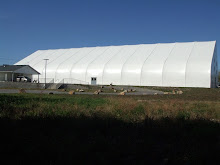That header sounds like this will be a training blog, but it's not. It's about listening to what your dog is trying to tell you, and learning to watch your dog's body signals. It's about lameness.
Many years ago I took Equestrian Science at William Woods. There, in addition to learning to ride horses that were often either rank or sour, we dealt with a lot of lame horses. I don't know how it's done now, but in those days all the horses used at WW were donated, and nobody was going to donate a horse that didn't have problems of some sort or another. We had structure and gait analysis drummed into our heads and I could still wrap a leg if I needed to. Once I moved into dogs I used to spend hours sitting at a corner of the breed ring where I could see both sidegait and the down and back. I'd play the "solve the puzzle" game of why a certain structure produced a certain gait. I'd link a dog with flying elbows to a short upper arm or a crabbing dog to too much rear angulation. And I saw a lot of lameness.
I'm rarely around the breed ring any more, spending most of my time with my obsession with agility. But I am constantly shocked at how many dogs I see in the agility ring that are lame. Some of it is caused by structure. And some of it is injury related. I see owners berating dogs for not jumping when the dog clearly can't, or cheerleading their dog around the course when it is wincing with each stride. And I don't think owners are cruel. I don't think they are doing it on purpose. I think they don't know. They don't know what to look for and how to catch it. Or maybe they see a really small limp and think it's minor and it'll go away. They are not listening to or watching their dogs in a meaningful way.
Dogs as a species are incredibly stoic. Way back in their hindbrain is the knowledge that if they get lame or unfit they will be ostracized from the pack or even killed. So they hide it as much as they can. And unfortunately, not taking care of lamenesses when they're minor very often leads to a major problem down the line. So the trick is learning first how to SEE lamenesses, then how to treat them. Often when a dog has a minor limp there's very little a traditional vet can do. But a canine acupuncturist or chiropractor may be able to work wonders.
Right now, I have 3 dogs, all of which are lame.
Cala either jammed or broke a toe Monday night training at the building. I already know that just like with people, there's not much you can do for a dog with a broken toe. But I'm taking it seriously; I've pulled her from agility training and may have to pull her from next weekend's Rally show. The limp is very mild most of the time. Would you have noticed? I did.
Last week I saw Zipper carry his right hind leg for a couple of steps. Time for an appointment with our genius acupuncturist, Sherry Russell DVM. Turns out he's got a back injury. Not major, but enough for a treatment. It's the kind of thing, Dr. Russell told me, that's easily fixable at this stage but could have caused big problems if I hadn't addressed it. My bet is, most owners wouldn't have even seen it.
My old girl, Viva, hasn't been any more lame than usual for a dog with spondylosis in her spine and arthritis in her feet, but she's had lick sores that have been getting worse. And it turns out she's in far worse shape than I thought. Dr. Russell wasn't sure how she was getting up and walking. That will take several treatments over a series of months. I almost dismissed it as old dog syndrome.
So please do your dog a favor. Learn how to look for lameness and make it a daily habit to watch your dog move. When something changes, even if you don't know what it is, something is probably wrong. And if you need to learn how to look at this stuff, Dr. John Sherman, founder of the renown canine rehabilitation clinic VetHab will be here in town Saturday giving a seminar. If you want more information, go to our website, www.columbiak9sportscenter.com.
Thursday, February 28, 2008
Listening and watching
Subscribe to:
Post Comments (Atom)




1 comment:
Very interesting info. Since I'm my Mum's first dog ever, it's really hard for her to 'see' things in me that just aren't right. But she's learning.
Sure wish we could learn more about what to look for - maybe you could expand upon the subject and give us some detailed insight? I'd really be interested.
Woofs, Johann
Post a Comment